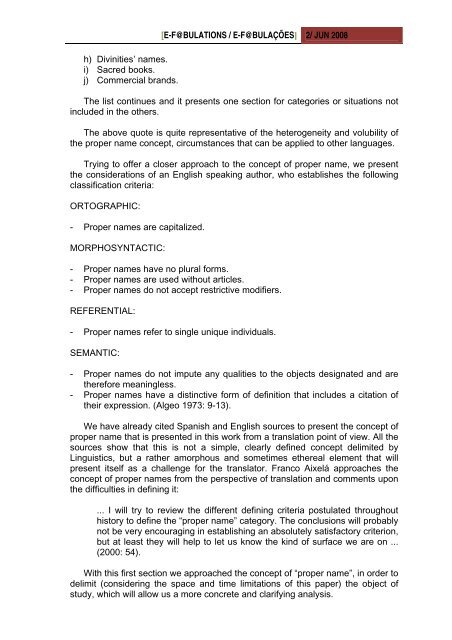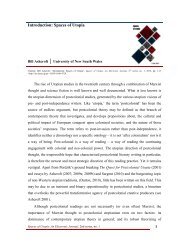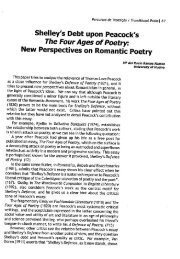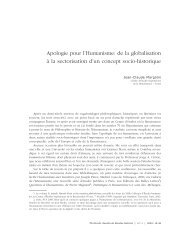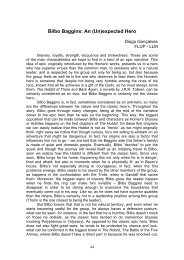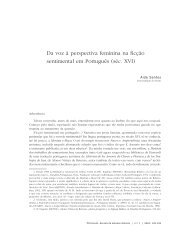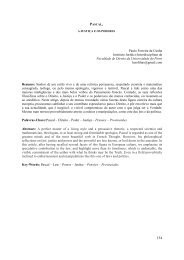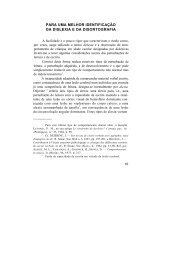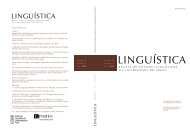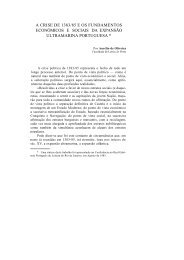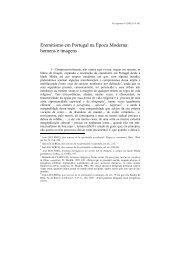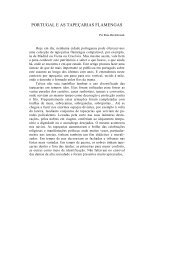e-f@bulações - Biblioteca Digital - Universidade do Porto
e-f@bulações - Biblioteca Digital - Universidade do Porto
e-f@bulações - Biblioteca Digital - Universidade do Porto
Create successful ePaper yourself
Turn your PDF publications into a flip-book with our unique Google optimized e-Paper software.
h) Divinities’ names.<br />
i) Sacred books.<br />
j) Commercial brands.<br />
[E-F@BULATIONS / E-F@BULAÇÕES] 2/ JUN 2008<br />
The list continues and it presents one section for categories or situations not<br />
included in the others.<br />
The above quote is quite representative of the heterogeneity and volubility of<br />
the proper name concept, circumstances that can be applied to other languages.<br />
Trying to offer a closer approach to the concept of proper name, we present<br />
the considerations of an English speaking author, who establishes the following<br />
classification criteria:<br />
ORTOGRAPHIC:<br />
- Proper names are capitalized.<br />
MORPHOSYNTACTIC:<br />
- Proper names have no plural forms.<br />
- Proper names are used without articles.<br />
- Proper names <strong>do</strong> not accept restrictive modifiers.<br />
REFERENTIAL:<br />
- Proper names refer to single unique individuals.<br />
SEMANTIC:<br />
- Proper names <strong>do</strong> not impute any qualities to the objects designated and are<br />
therefore meaningless.<br />
- Proper names have a distinctive form of definition that includes a citation of<br />
their expression. (Algeo 1973: 9-13).<br />
We have already cited Spanish and English sources to present the concept of<br />
proper name that is presented in this work from a translation point of view. All the<br />
sources show that this is not a simple, clearly defined concept delimited by<br />
Linguistics, but a rather amorphous and sometimes ethereal element that will<br />
present itself as a challenge for the translator. Franco Aixelá approaches the<br />
concept of proper names from the perspective of translation and comments upon<br />
the difficulties in defining it:<br />
... I will try to review the different defining criteria postulated throughout<br />
history to define the “proper name” category. The conclusions will probably<br />
not be very encouraging in establishing an absolutely satisfactory criterion,<br />
but at least they will help to let us know the kind of surface we are on ...<br />
(2000: 54).<br />
With this first section we approached the concept of “proper name”, in order to<br />
delimit (considering the space and time limitations of this paper) the object of<br />
study, which will allow us a more concrete and clarifying analysis.


